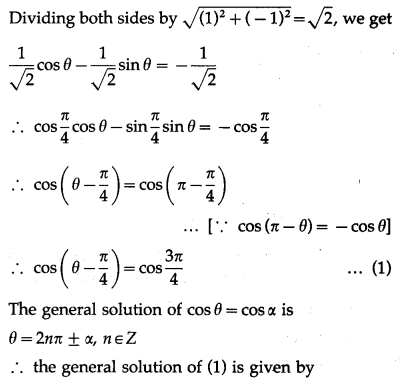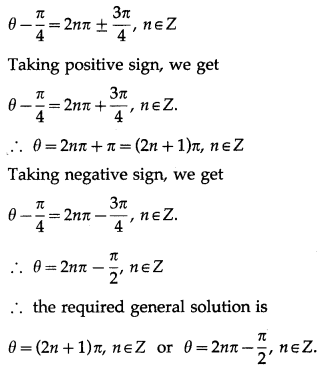Chapter 3 Trigonometric Functions Miscellaneous Exercise 3
I) Select the correct option from the given alternatives.
Question 1.
The principal of solutions equation sinθ = −1/2 are ________.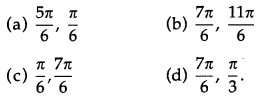
Solution:
(b) 7π6,11π6
Question 2.
The principal solution of equation cot θ = √3 ___________.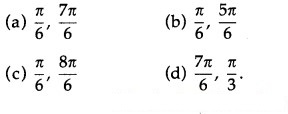
Solution:
Question 3.
The general solution of sec x = √2 is __________.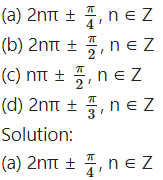
Question 4.
If cos pθ = cosqθ, p ≠ q rhen ________.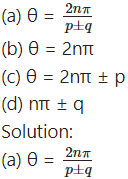
Question 5.
If polar co-ordinates of a point are (2,π/4) then its cartesian co-ordinates are ______.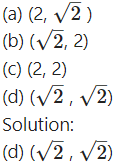
Question 6.
If √3 cosx – sin x = 1, then general value of x is _________.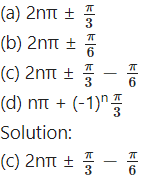
Question 7.
In ∆ABC if ∠A = 45°, ∠B = 60° then the ratio of its sides are _________.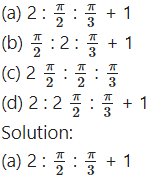
Question 8.
In ∆ABC, if c2 + a2 – b2 = ac, then ∠B = __________.
Question 9.
In ABC, ac cos B – bc cos A = ____________.
(a) a2 – b2
(b) b2 – c2
(c) c2 – a2
(d) a2 – b2 – c2
Solution:
(a) a2 – b2
Question 10.
If in a triangle, the are in A.P. and b : c = √3 : √2 then A is equal to __________.
(a) 30°
(b) 60°
(c) 75°
(d) 45°
Solution:
(c) 75°
Question 11.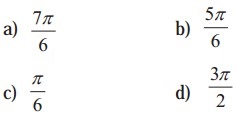
Question 12.
The value of cot (tan-1 2x + cot-1 2x) is __________.
(a) 0
(b) 2x
(c) π + 2x
(d) π – 2x
Solution:
(a) 0
Question 13.
Solution:![]()
Question 14.
Question 16.
Question 17.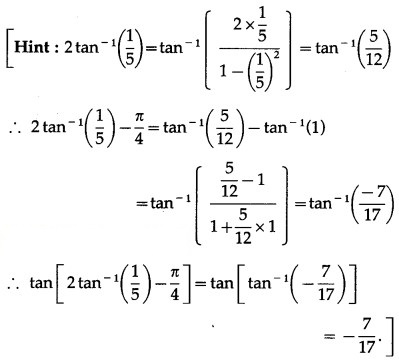
Question 18.
The principal value branch of sec-1 x is __________.
Solution:
Question 20.
If tan θ + tan 2θ + tan 3θ = tan θ∙tan 2θ∙tan 3θ, then the general value of the θ is _______.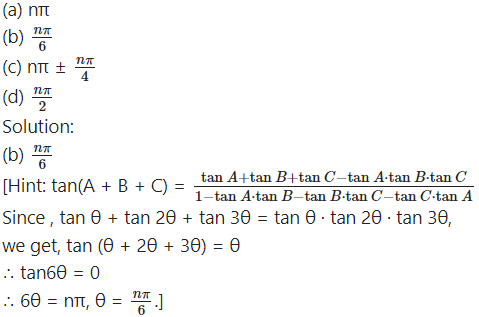
Question 21.
If any ∆ABC, if a cos B = b cos A, then the triangle is ________.
(a) Equilateral triangle
(b) Isosceles triangle
(c) Scalene
(d) Right angled
Solution:
(b) Isosceles triangle
II: Solve the following
Question 1.
Find the principal solutions of the following equations :
(i) sin2θ = −1/2
Solution:
sin2θ = −1/2
Since, θ ∈ (0, 2π), 2∈ ∈ (0, 4π)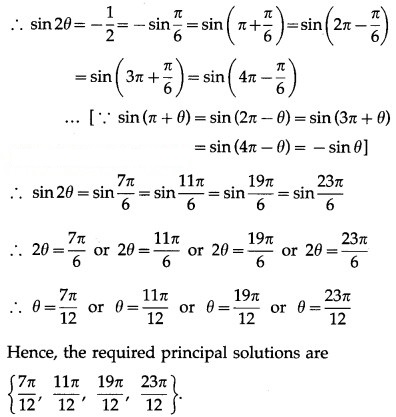
(ii) tan3θ = -1
Solution:
Since, θ ∈ (0, 2π), 3∈ ∈ (0, 6π)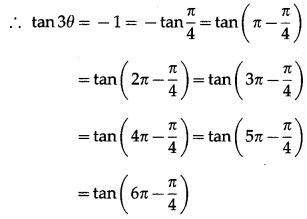
… [∵ tan(π – θ) = tan(2π – θ) = tan(3π – θ)
= tan (4π – θ) = tan (5π – θ) = tan (6π – θ) = -tan θ]![]()

(iii) cotθ = 0
Solution:
Question 2.
Find the principal solutions of the following equations :
Solution:
(ii) tan5θ = -1
Solution:
(iii) cot2θ = 0
Solution:
Question 3.
Which of the following equations have no solutions ?
(i) cos 2θ = 1/3
Solution:
cos 2θ = 1/3
Since 1/3 ≤ cosθ ≤ 1 for any θ
cos2θ = 1/3 has solution
(ii) cos2 θ = -1
Solution:
cos2θ = -1
This is not possible because cos2θ ≥ 0 for any θ.
∴ cos2θ = -1 does not have any solution.
(iii) 2 sinθ = 3
Solution:
2 sin θ = 3 ∴ sin θ = 3/2
This is not possible because -1 ≤ sin θ ≤ 1 for any θ.
∴ 2 sin θ = 3 does not have any solution.
(iv) 3 sin θ = 5
Solution:
3 sin θ = 5
∴ sin θ = 5/3
This is not possible because -1 ≤ sin θ ≤ 1 for any θ.
∴ 3 sin θ = 5 does not have any solution.
Question 4.
Find the general solutions of the following equations :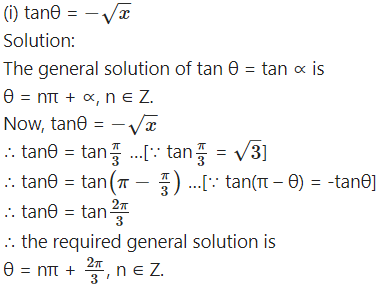
(ii) tan2θ = 3
Solution: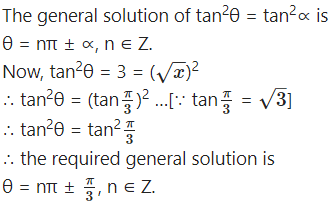
(iii) sin θ – cosθ = 1
Solution:
∴ cosθ – sin θ = -1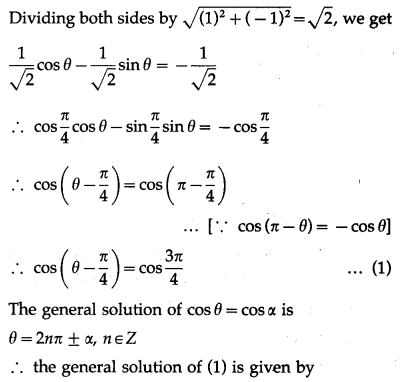
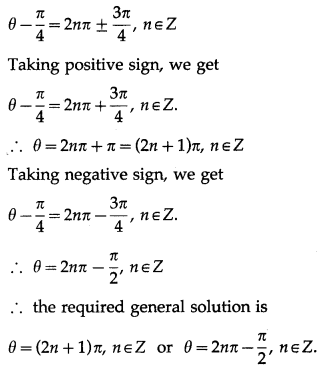
(iv) sin2θ – cos2θ = 1
Solution:
sin2θ – cos2θ = 1
∴ cos2θ – sin2θ = -1
∴ cos2θ = cosπ …(1)
The general solution of cos θ = cos ∝ is
θ = 2nπ ± ∝, n ∈ Z
∴ the general solution of (1) is given by
2θ = 2nπ ± π, n ∈ Z
∴ θ = nπ ± π2, n ∈ Z
Question 5.
Solution:
By the sine rule,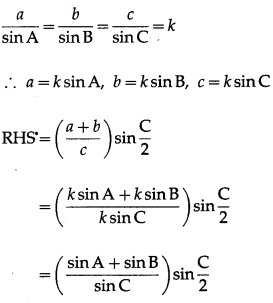

Question 6.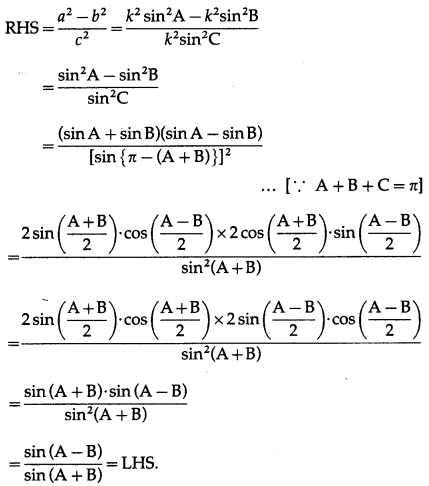
Question 7.
Question 8.
In ∆ABC if cosA = sin B – cos C then show that it is a right angled triangle.
Solution:
cos A= sin B – cos C
∴ cos A + cos C = sin B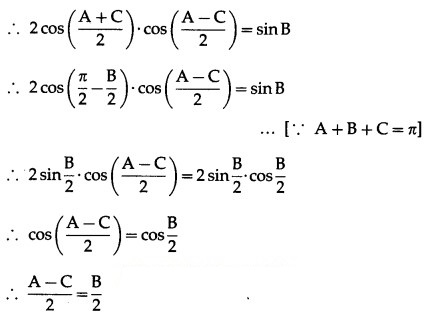
∴ A – C = B
∴ A = B + C
∴ A + B + C = 180° gives
A + A = 180°
∴ 2A = 180 ∴ A = 90°
∴ ∆ ABC is a rightangled triangle.
Question 9.
∴ sin [π – (B + C)] ∙ sin (B – C)
= sin [π – (A + B)]∙sin (A – B) … [∵ A + B + C = π]
∴ sin(B + C) ∙ sin(B – C) = sin (A + B) ∙ sin (A – B)
∴ sin2B – sin2C = sin2A – sin2B
∴ 2 sin2B = sin2A + sin2C
∴ 2k2b2 = k2a2 + k2c2
∴ 2b2 = a2 + c2
Hence, a2, b2, c2 are in A.P.
Question 10.
∴ sin A = sin 60° cos 45° + cos 60° sin 45°
and sin B = sin 60° cos 45° – cos 60° sin 45°
∴ sin A = sin (60° + 45°) – sin 105°
and sin B = sin (60° – 45°) = sin 15°
∴ A = 105° and B = 15°
Hence, A = 105°, B 15° and C = √6 units.
Question 11.
In ∆ABC prove the following :
(i) a sin A – b sin B = c sin (A – B)
Solution:
By sine rule,![]()
∴ a = ksinA, b = ksinB, c = ksinC,
LHS = a sin A – b sinB
= ksinA∙sinA – ksinB∙sinB
= k (sin2A – sin2B)
= k (sin A + sin B)(sin A – sin B)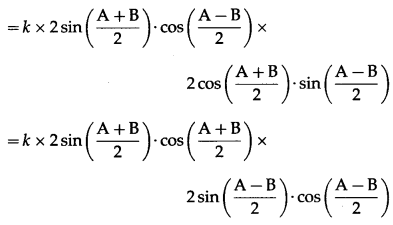
= k × sin (A + B) × sin (A – B)
= ksin(π – C)∙sin(A – B) … [∵ A + B + C = π]
= k sinC∙sin (A – B)
= c sin (A – B) = RHS.

Solution:
(iii) a2 sin (B – C) = (b2 – c2) sinA
Solution:
By sine rule,![]()
∴ a = ksinA, b = ksinB, c = ksinC
RHS = (b2 – c2) sin A
= (k2sin2B – k2sin2C)sin A
= k2(sin2B – sin2C) sin A
= k2(sin B + sin C)(sin B – sin C) sin A
= k2 × sin (B + C) × sin (B – C) × sin A
= k2∙sin(π – A)∙sin(B – C)∙sinA … [∵ A + B + C = π]
= k2sin A∙sin (B – C)∙sin A
= (k sin A)2∙sin (B – C)
= a2sin (B – C) = LHS.
(iv) ac cos B – bc cos A = (a2 – b2).
Solution: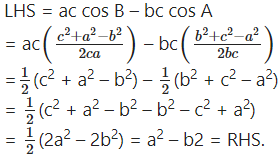
Solution: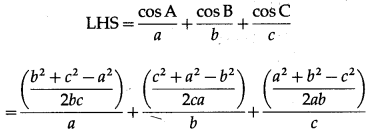

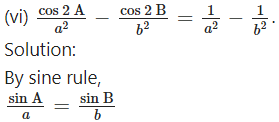


Solution:
By sine rule,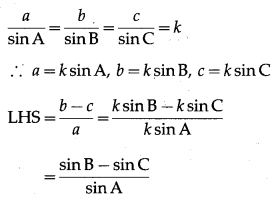
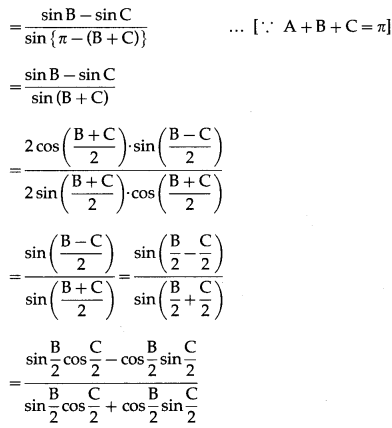
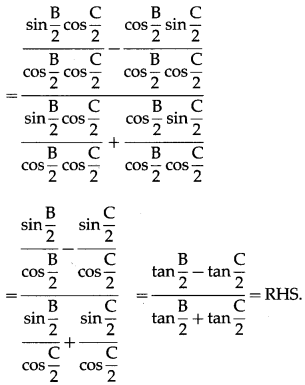
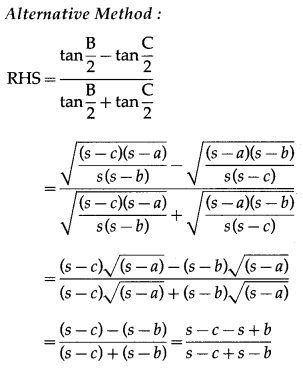
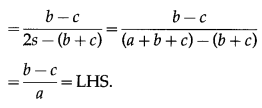
Question 12.
Solution:
a, b, c, are in A.P.
∴ 2b = a + c …(1)
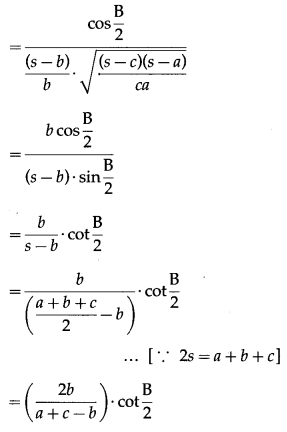


Question 13.
Solution:
In ∆ABC, if ∠C = 90º
∴ c2 = a2 + b2 …(1)
By sine rule,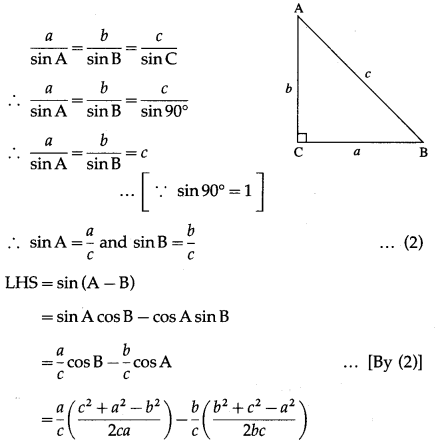

Question 14.
By sine rule,
∴ sin A cos B = cos A sinB
∴ sinA cosB – cosA sinB = 0
∴ sin (A – B) = 0 = sin0
∴ A – B = 0 ∴ A = B
∴ the triangle is an isosceles triangle.
Question 15.
In ∆ABC if sin2A + sin2B = sin2C then prove that the triangle is a right angled triangle.
Question is modified
In ∆ABC if sin2A + sin2B = sin2C then show that the triangle is a right angled triangle.
Solution:
By sine rule,![]()
∴ sin A = ka, sinB = kb, sin C = kc
∴ sin2A + sin2B = sin2C
∴ k2a2 + k2b2 = k2c2
∴ a2 + b2 = c2
∴ ∆ABC is a rightangled triangle, rightangled at C.
Question 16.
In ∆ABC prove that a2(cos2B – cos2C) + b2(cos2C – cos2A) + c2(cos2A – cos2B) = 0.
Solution:
By sine rule,![]()
LHS = a2(cos2B – cos2C) + b2( cos2C – cos2A) + c2(cos2A – cos2B)
= k2sin2A [(1 – sin2B) – (1 – sin2C)] + k2sin2B [(1 – sin2C) – (1 – sin2A)] + k2sin2C[(1 – sin2A) – (1 – sin2B)]
= k2sin2A (sin2C – sin2B) + k2sin2B(sin2A – sin2C) + k2sin2C (sin2B – sin2A)
= k2(sin2A sin2C – sin2Asin2B + sin2A sin2B – sin2B sin2C + sin2B sin2C – sin2A sin2C)
= k2(0) = 0 = RHS.
Question 17.
With usual notations show that (c2 – a2 + b2) tan A = (a2 – b2 + c2) tan B = (b2 – c2 + a2) tan C.
Solution:
By sine rule,![]()
∴ a = fksinA, b = ksinB, c = ksinC
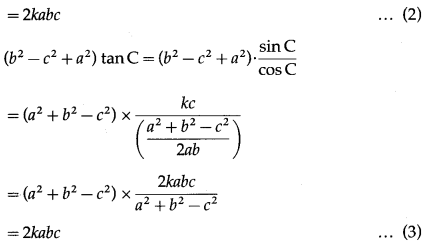
From (1), (2) and (3), we get
(c2 – a2 + b2) tan A = (a2 – b2 + c2) tan B
= (b2 – c2 + a2) tan C.
Question 18.
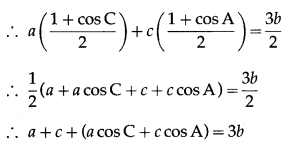
∴ a + c + b = 3b …[∵ a cos C + c cos A = b]
∴ a + c = 2b
Hence, a, b, c are in A.P.
Question 19.
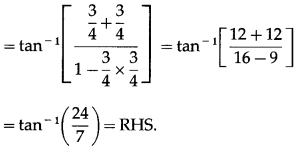
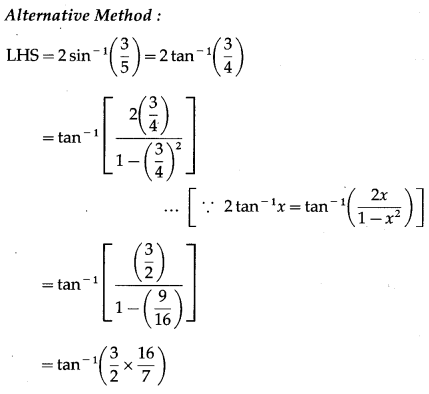

Solution: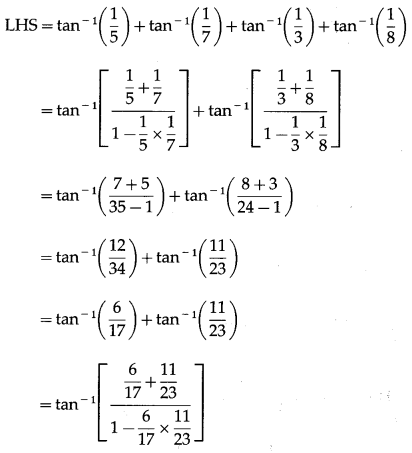
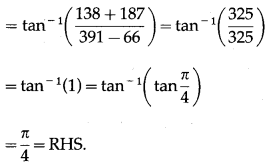
Question 21.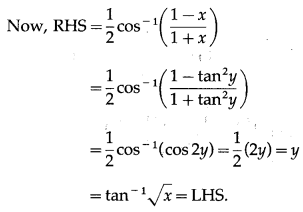
Question 22.
Solution:
We have to show that
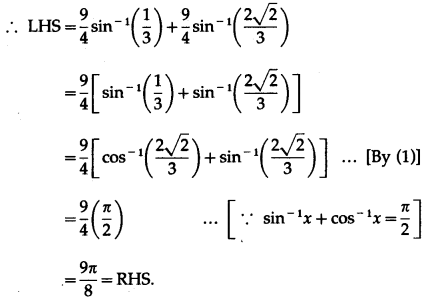
Question 23.
Show that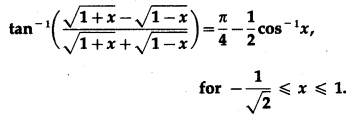
Solution: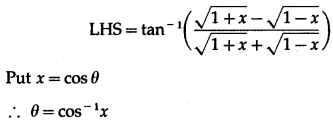
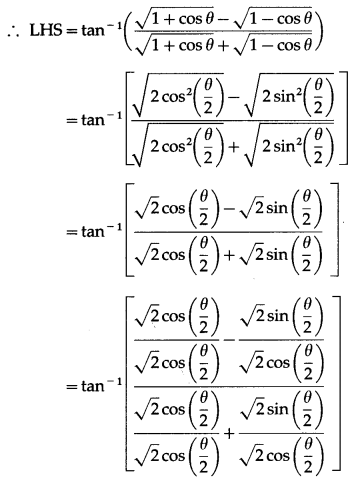

Question 24.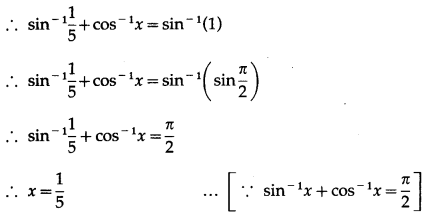
Question 25.
If tan-1(x−1x−2) + tan-1(x+1x+2) = π4 then find the value of x.
Solution:
tan-1(x−1x−2) + tan-1(x+1x+2) = π4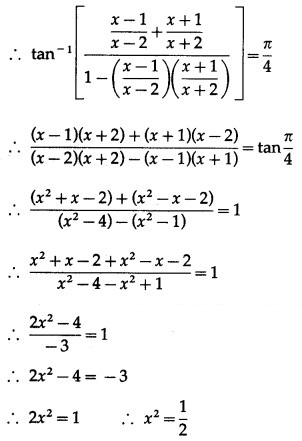
![]()
Question 26.
If 2 tan-1(cos x ) = tan-1(cosec x) then find the value of x.
Solution:
2 tan-1(cos x ) = tan-1(cosec x)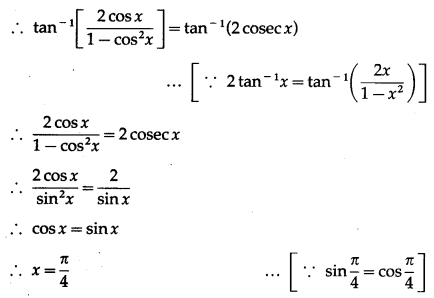
Question 27.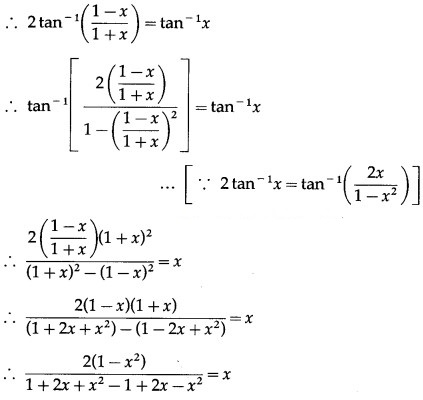
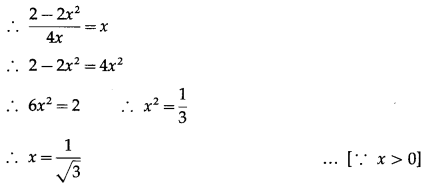
Question 28.
If sin-1(1 – x) – 2sin-1x = π/2, then find the value of x.
Solution:
sin-1(1 – x) – 2sin-1x = π/2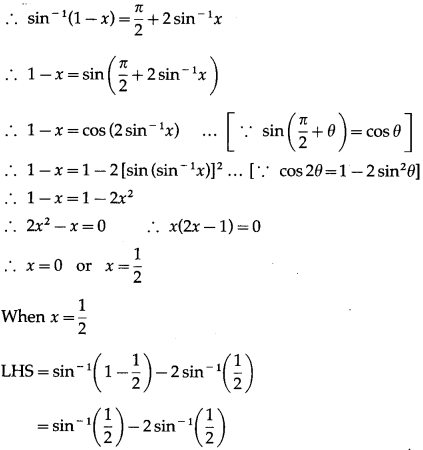
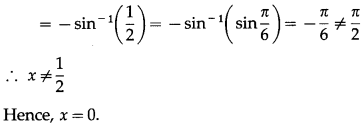
Question 29.
Question 30.
Question 31.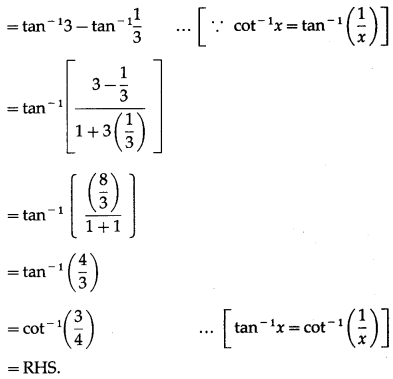
Question 32.
Solution:
We have to show that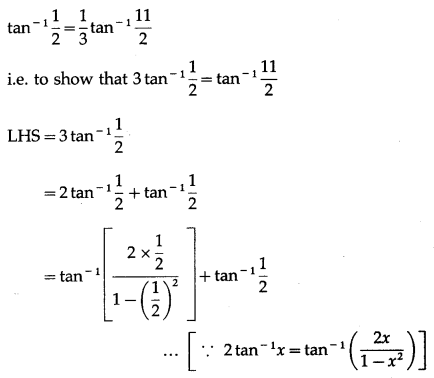
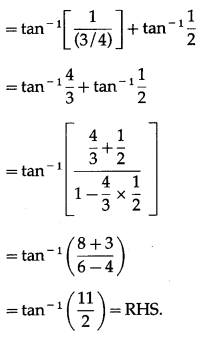
Question 33.
Solution: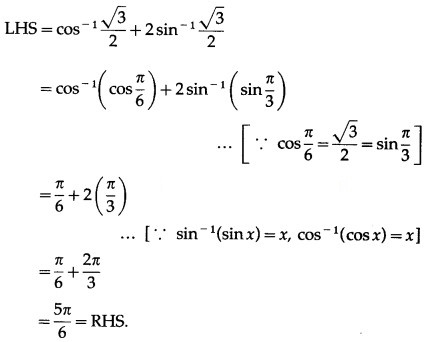
Question 34.
Solution: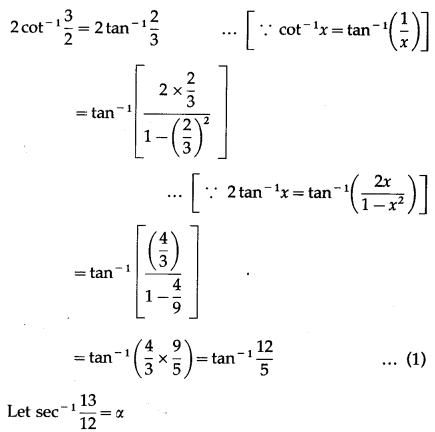
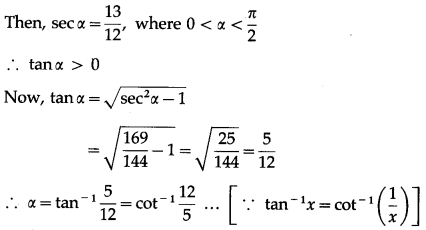
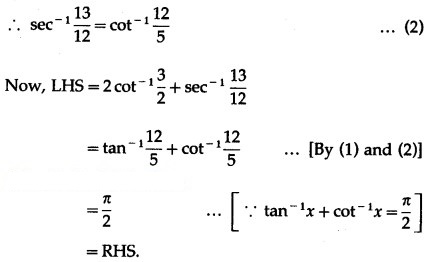
Question 35.
Prove the following :
Solution: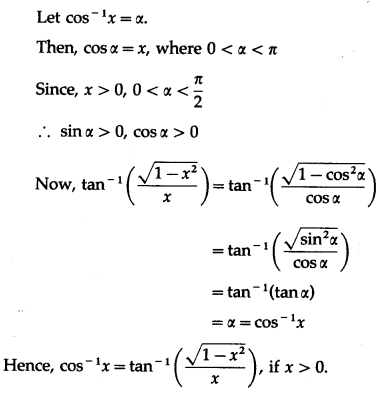
Solution:
Question 36.
Solution:
Let tan-1x = y
Then, x = tany
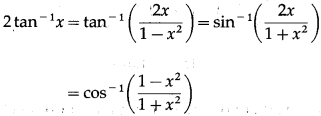
Question 37.
Solution:
Question 38.
If tan-1 x + tan-1 y + tan-1 z = π/2 then, show that xy + yz + zx = 1
Solution:
tan-1 x + tan-1 y + tan-1 z = π/2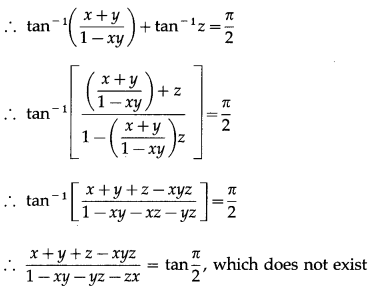
∴ 1 – xy – yz – zx = 0
∴ xy + yz + zx = 1.
Question 39.
If cos-1 x + cos-1 y + cos-1 z = π then show that x2 + y2 + z2 + 2xyz = 1.
Solution:
0 ≤ cos-1x ≤ π and
cos-1x + cos-1y+ cos-1z = 3π
∴ cos-1x = π, cos-1y = π and cos-1z = π
∴ x = y = z = cosπ = -1
∴ x2 + y2 + z2 + 2xyz
= (-1)2 + (-1)2 + (-1)2 + 2(-1)(-1)(-1)
= 1 + 1 + 1 – 2
= 3 – 2 = 1.
